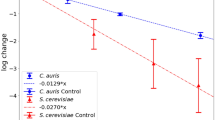Abstract.
As the main nitrogen source in Malassezia furfur, tryptophan induces the formation of fluorochromes and pigments, which make the yeast less sensitive to UV light. To detect a chemical UV filter, M. furfur (CBS 1878) was incubated at 30ºC for 14 days on a pigment-inducing medium and agar extracts were purified by column chromatography, preparative TLC and HPLC. Structural analysis of the pure metabolites was performed by mass spectroscopy and NMR. A yellow compound eluting from the column with 64% acetonitrile was found to be a potential UV filter because of its broad UV absorption (λmax 389, 315, 289, 212 nm). It was an indole derivative (C20H13N3O; pityriacitrin) which had recently been shown to be a potent UV filter in bacteria. Its UV protective properties were confirmed in a yeast model and also in humans. Pityriasis versicolor induced by Malassezia yeasts is characterized by depigmented skin areas showing reduced melanin synthesis but no increased UV sensitivity. This UV protection might be explained by the presence of pityriacitrin which is produced by M. furfur.
Similar content being viewed by others
Author information
Authors and Affiliations
Additional information
Electronic Publication
Rights and permissions
About this article
Cite this article
Mayser, P., Schäfer, U., Krämer, HJ. et al. Pityriacitrin – an ultraviolet-absorbing indole alkaloid from the yeast Malassezia furfur . Arch Dermatol Res 294, 131–134 (2002). https://doi.org/10.1007/s00403-002-0294-2
Received:
Revised:
Accepted:
Published:
Issue Date:
DOI: https://doi.org/10.1007/s00403-002-0294-2




